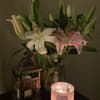Podcast
Questions and Answers
What is the movement of water from an area of high concentration to an area of low concentration called?
What is the movement of water from an area of high concentration to an area of low concentration called?
Osmosis
What are the three main types of transport proteins?
What are the three main types of transport proteins?
Channel proteins, Carrier proteins, and Receptor proteins
What is the type of active transport that moves materials out of the cell called?
What is the type of active transport that moves materials out of the cell called?
Exocytosis
Which type of endocytosis is most common?
Which type of endocytosis is most common?
What is the process called when a cell engulfs large particles such as food, bacteria, etc. into vesicles?
What is the process called when a cell engulfs large particles such as food, bacteria, etc. into vesicles?
Which of the following is NOT a type of passive transport?
Which of the following is NOT a type of passive transport?
Active transport moves materials from an area of low concentration to an area of high concentration.
Active transport moves materials from an area of low concentration to an area of high concentration.
Channel proteins can change shape to move materials from one side of the membrane to the other.
Channel proteins can change shape to move materials from one side of the membrane to the other.
What is the function of the Sodium-Potassium Pump?
What is the function of the Sodium-Potassium Pump?
In an isotonic solution:
In an isotonic solution:
What happens to a cell in a hypertonic solution?
What happens to a cell in a hypertonic solution?
The movement of materials into the cell by vesicles is called ______.
The movement of materials into the cell by vesicles is called ______.
Which of the following is a type of endocytosis?
Which of the following is a type of endocytosis?
Pinocytosis is a type of endocytosis that involves the engulfment of large particles.
Pinocytosis is a type of endocytosis that involves the engulfment of large particles.
Flashcards
Simple Diffusion
Simple Diffusion
Movement of molecules from high to low concentration without energy.
Facilitated Diffusion
Facilitated Diffusion
Movement of molecules across the membrane using transport proteins.
Active Transport
Active Transport
Movement of molecules from low to high concentration requiring energy (ATP).
Sodium-Potassium Pump
Sodium-Potassium Pump
Signup and view all the flashcards
Exocytosis
Exocytosis
Signup and view all the flashcards
Endocytosis
Endocytosis
Signup and view all the flashcards
Phagocytosis
Phagocytosis
Signup and view all the flashcards
Pinocytosis
Pinocytosis
Signup and view all the flashcards
Receptor-mediated endocytosis
Receptor-mediated endocytosis
Signup and view all the flashcards
Hypertonic Solution
Hypertonic Solution
Signup and view all the flashcards
Hypotonic Solution
Hypotonic Solution
Signup and view all the flashcards
Isotonic Solution
Isotonic Solution
Signup and view all the flashcards
Plasmolysis
Plasmolysis
Signup and view all the flashcards
Cytolysis
Cytolysis
Signup and view all the flashcards
Osmosis
Osmosis
Signup and view all the flashcards
Concentration Gradient
Concentration Gradient
Signup and view all the flashcards
Transport Proteins
Transport Proteins
Signup and view all the flashcards
ATP
ATP
Signup and view all the flashcards
Vesicles
Vesicles
Signup and view all the flashcards
Cell Membrane
Cell Membrane
Signup and view all the flashcards
Integral Proteins
Integral Proteins
Signup and view all the flashcards
Solute
Solute
Signup and view all the flashcards
Study Notes
Hypertonic Solutions
- A solution where the solute concentration is higher than the solute concentration inside a cell.
Isotonic Solutions
- A cell at equilibrium.
Hypotonic Solutions
- Water moves inside the cell.
Osmosis
- The movement of water across a semipermeable membrane from an area of high water concentration to an area of low water concentration.
Cytolysis
- The destruction of a cell. Cells swell and burst.
Plasmolysis
- The shrinking of a cell. Cells shrink and shrivel.
Simple Diffusion
- Movement of molecules from an area of high concentration to an area of low concentration. No energy required.
Facilitated Diffusion
- Uses transport proteins to move molecules from high to low concentration. No energy required.
Channel Proteins
- Embedded in the cell membrane with a pore for molecules to pass through.
Carrier Proteins
- Change shape to transport molecules across the membrane. Some extend through the membrane, while others don't.
Active Transport
- Requires energy (ATP) to move molecules from an area of low concentration to an area of high concentration against the concentration gradient.
Exocytosis
- Moves materials OUT of the cell via vesicles that fuse with the plasma membrane.
Endocytosis
- Moves molecules INTO the cell by vesicles formed by the cell membrane. Has three types:
- Phagocytosis (cell eating) - Engulfs large particles like food, bacteria.
- Pinocytosis (cell drinking) - Takes in dissolved molecules.
- Receptor-mediated endocytosis - Receptors on the cell membrane recognize specific molecules and take them in.
Cell Eating (Phagocytosis)
- Cells engulf large particles, such as food or bacteria, into vesicles.
Receptor-Mediated Endocytosis
- Some integral proteins have receptors on the surface to recognize and take in hormones, cholesterol, etc.
Studying That Suits You
Use AI to generate personalized quizzes and flashcards to suit your learning preferences.





